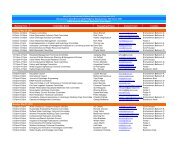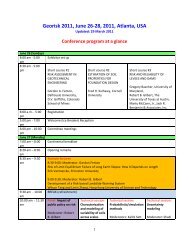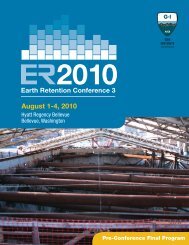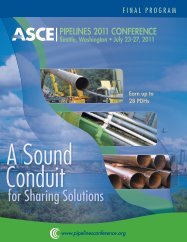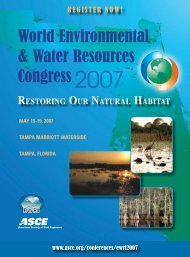Final Program - American Society of Civil Engineers
Final Program - American Society of Civil Engineers
Final Program - American Society of Civil Engineers
You also want an ePaper? Increase the reach of your titles
YUMPU automatically turns print PDFs into web optimized ePapers that Google loves.
SHORT COURSES<br />
You must purchase a separate ticket for short courses; this is not<br />
included in your daily or full Congress registration. Full-day courses<br />
include morning c<strong>of</strong>fee, morning and afternoon breaks, and lunch.<br />
half-day courses include morning c<strong>of</strong>fee and morning or afternoon<br />
break; lunch tickets are available for purchase.<br />
HALF-DAY SHORT COURSES<br />
(includes morning c<strong>of</strong>fee & morning or afternoon break)<br />
PDHs: 3.5<br />
Fees: Member: $125<br />
Non-Member: $145<br />
Student: $25<br />
MASW (MULTICHANNEL ANALYSIS<br />
OF SURFACE WAVES)<br />
7:30 – 11:45 a.m.<br />
location: Grand Ballroom B<br />
MASW is a multichannel seismic method used to determine the shearwave<br />
velocity (Vs) <strong>of</strong> ground (1-D and 2-D) down to depths <strong>of</strong> a few<br />
tens <strong>of</strong> meters. The method uses surface waves which contribute more<br />
than 70% <strong>of</strong> the total seismic wave energy and therefore represent the<br />
most troublesome noise during the conventional seismic surveys. Come<br />
see how to generate and record surface waves!<br />
You Will Gain Knowledge About:<br />
■■ How to generate and record surface waves<br />
■■ The multichannel seismic survey<br />
■■ How to collect field data (active and Passive MASW)<br />
■■ How to process data (active and passive MASW)<br />
Instructor: Choon B. Park, Ph.D., Park Seismic llC<br />
TESTING AND ANALYSIS OF PILES, AND DESIGN<br />
OF PILE FOUNDATIONS<br />
7:30 – 11:45 a.m.<br />
location: Grand Ballroom A<br />
The current trend in deep foundations is towards larger loads, larger<br />
diameter, and deeper piles, and the supported structures are becoming<br />
more sensitive to foundation deformation. As a result, static loading<br />
tests on instrumented piles are becoming more common. Additionally,<br />
the practice is increasingly requiring detailed analysis <strong>of</strong> the test and<br />
implementing the analysis results in foundation design. Advanced deep<br />
foundation design is a good deal more than finding some value <strong>of</strong><br />
capacity. Indeed, capacity is not the primary issue, but load distribution<br />
and settlement under service load are. In this course, you will share in<br />
the broad generalities and in-depth details regarding several testing<br />
and analysis examples <strong>of</strong> piles and the design <strong>of</strong> piled foundations.<br />
You Will Gain Knowledge About:<br />
■■ The pros and cons <strong>of</strong> the current methods <strong>of</strong> testing and the<br />
conventional head-down and the O-cell tests in reference to case<br />
histories.<br />
■■ Construction aspects.<br />
■■ Load and Resistance Factor Design (LRFD).<br />
■■ The basic principles <strong>of</strong> effective stress analysis which are correlated<br />
to case histories involving instrumented piles, residual load, and<br />
development over time.<br />
■■ The principles <strong>of</strong> settlement analysis <strong>of</strong> single piles and small and<br />
large pile groups from aspects <strong>of</strong> load directly on the piles and from<br />
influence from adjacent activity.<br />
■■ The design in settling ground and reclaimed land where piles will be<br />
affected by drag load and down drag and the “Unified pile design<br />
| 4 | www.geocongress2012.org<br />
method for capacity, settlement, drag load, and down drag” using<br />
actual project examples.<br />
Instructor: Bengt H. Fellenius, Dr.Tech., P.Eng., M.ASCE,<br />
Consulting Engineer<br />
INTRODUCTION TO TUNNELING<br />
12:00 – 4:15 p.m.<br />
location: Grand Ballroom B<br />
In today’s society <strong>of</strong> increased environmental concern and sensitivity,<br />
population increase, and urbanization, there is demand for fast<br />
and sustainable transportation <strong>of</strong> people, water, and goods, along<br />
with production and storage <strong>of</strong> energy. Tunnels and underground<br />
excavations <strong>of</strong>ten provide a life-cycle cost-effective alternative to surface<br />
or aerial infrastructure. The major benefit <strong>of</strong> this tunneling short course is<br />
to provide you a structured introduction to this field <strong>of</strong> application, with<br />
special emphasis on the geotechnical community.<br />
You Will Gain Knowledge About:<br />
■■ Tunnel behavior<br />
■■ The typical design and construction workflow<br />
■■ How to describe and outline the investigation, diagnosis, and<br />
therapy phases <strong>of</strong> tunnel design<br />
■■ The difference between confinement and pre-confinement<br />
■■ The nomenclature on excavation systems<br />
■■ How to identify the objectives and techniques for monitoring<br />
Instructors: Fulvio Tonon, Ph.D., P.E., M.ASCE, University <strong>of</strong><br />
Texas at Austin<br />
RELIABILITY ANALYSIS AND DESIGN<br />
IN GEOTECHNICAL ENGINEERING<br />
12:00 – 4:15 p.m.<br />
location: Grand Ballroom A<br />
Reliability-based design (RBD) is increasingly mandated by new<br />
generation geotechnical codes <strong>of</strong> practice. The key objective <strong>of</strong> this short<br />
course is to cover the four “need to know” concepts below so you will<br />
learn how to compute a reliability index in a realistic and robust way.<br />
1. Familiarization with basic probability tools<br />
2. Estimation <strong>of</strong> geotechnical uncertainties<br />
3. Calculation <strong>of</strong> reliability index using Excel<br />
4. Illustration using design examples<br />
You are encouraged to bring your laptop to follow the hands-on Excel<br />
demonstrations and, if time permits, to try additional worked examples under<br />
the guidance <strong>of</strong> the instructors. This course, conducted in various locales<br />
such as Taipei, Shanghai, and Munich, is based in part, on the textbook<br />
“Reliability-Based Design in Geotechnical Engineering: Computations and<br />
Applications” by KK Phoon (ed.), Taylor & Francis, 2008.<br />
You Will Gain Knowledge About:<br />
■■ Basic probability tools<br />
■■ Geotechnical uncertainty estimations<br />
■■ How to calculate reliability index using Excel<br />
■■ Illustration<br />
Instructors: Kok-Kwang Phoon, Ph.D., P.E., F.ASCE,<br />
national University <strong>of</strong> Singapore; Jianye Ching, Ph.D., C.Eng,<br />
M.ASCE, national Taiwan University



